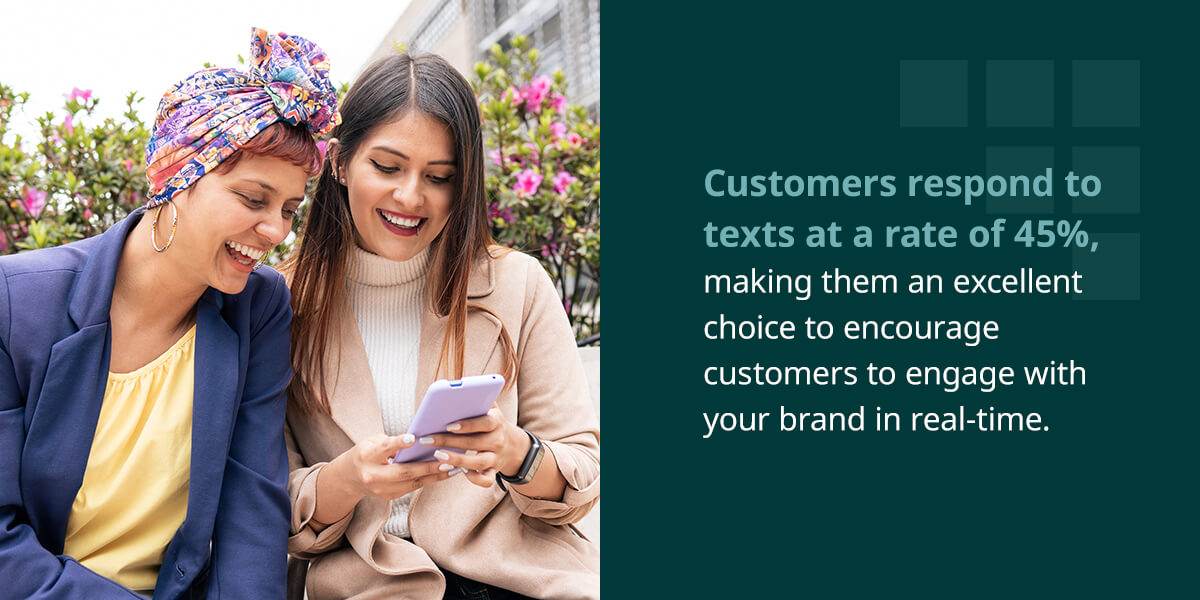The SMS market is booming and is projected to grow by a CAGR of 21% between 2023 and 2030. SMS marketing is one of the most effective strategies for marketing communications, boasting consistently higher open and read rates than email. Simply put, businesses are sending a lot of simple text messages to communicate with customers and boost sales.
This also means consumers are receiving a lot of text messages. How do you ensure yours are not only being read, but driving action among your customers? Read on to learn the benefits of an effective SMS marketing strategy and the best practices that will help yours get results.
What Is an SMS Marketing Strategy?
Short message service (SMS)—or text messaging—is an effective method of instant communication with your customers and an ideal platform for time-sensitive offers like sales, promotions and appointment reminders. When used for the right message types, SMS marketing can be a key component of your overall marketing strategy, providing you with a platform customers engage with and trust.
Why SMS Marketing?
With so many new technologies available to businesses to get messages to customers, it’s fair to ask why SMS marketing should be part of your strategy. Here are just a few reasons among many:
Making Customers Feel Good
Receiving a text is an interactive experience. Your screen lights up, your phone vibrates and you get a surge of dopamine. Anticipating and receiving texts reinforces the reward cycle in customers’ brains, making them excited to receive and read them.
Communicating Directly and Immediately
Text messages reach customers where they’re most comfortable. They arrive immediately, and people often read them as soon as they get one—which is key for reaching large volumes of people in a short time.
Customers can also receive messages from you directly without the hassle of downloading an app, opening an email or visiting your website. They can still engage with your brand whether they use other communication channels or not, and you can reach audiences who may not have a smartphone or Wi-Fi connection.
Engaging Your Customers
In addition to higher open rates, text messages have a shorter response time than other channels. Customers respond to texts at a rate of 45%, making them an excellent choice to encourage customers to engage with your brand in real time. More importantly, text messages often have a higher conversion rate than other marketing channels. People are more likely to act on offers you share via SMS than any other marketing service.
Reaching Out on Customers’ Terms
Customers are often more receptive to messages they receive via SMS. Many prefer engaging on their terms, making SMS preferable over email or phone calls. Adding SMS to your engagement options gives customers more power to choose how they interact with your brand. That in itself is valuable for fostering loyalty.
Enjoying Versatility
SMS marketing has applications across industries. You can use it to engage, acquire and retain customers via coupons, special offers, appointment reminders and time-sensitive updates. In addition, SMS marketing can play a role at every stage in the customer journey. You can use it for promotional and transactional communications, from nurturing brand awareness to sending password information or payment and delivery updates.
Whether you have a daycare facility, operate a multinational corporation, serve the community or manage a restaurant, SMS marketing can help your organization connect with the people who matter the most.
Creating Clear and Concise Marketing Messages
An SMS message gives you 160 characters to work with, forcing you to keep it brief. You must choose words that get to the core of each communication. Short, simple messages are powerful in customers’ busy lives. They appreciate you reaching the point quickly so they can engage with your contact with minimal effort.
Integrating with Other Channels
While SMS is an effective standalone channel, it can elevate and support other marketing mediums. A simple example is sending an SMS to follow up on a social media post or email, ensuring your customers are exposed to your message across multiple platforms.
Related eBook: Context Is Key: How to Break Through the Notification Noise to Drive Customer Engagement
How to Run Your SMS Marketing Platform the Right Way
SMS can engage your audiences and transform your marketing efforts. However, you must design your SMS marketing strategy with customers at the center. Keep these best practices in mind to ensure your text messages engage your customers:
1. Get Permission
SMS is permission-based by law, which means customers need to opt in before you can contact them on this platform. As you can only send SMS to customers who give you explicit permission, consider getting them to opt in through your website or email.
When they subscribe, send them a message confirming their subscription. They can reply with a simple yes or no, and if they don’t, assume they’ve opted out.
2. Provide the Option to Opt Out
Sending messages to people who don’t want them is more likely to lose customers than keep them. Customers must know how to opt out of your communications at any time. Provide them with instructions in your first text message, as it’s an SMS marketing best practice and a legal requirement in some cases.
Include opt-out information for every SMS communication, including transactional messages like appointment reminders and delivery updates.
3. Introduce Yourself
Your customers should know who you are when they receive your message, especially the first time. Consider branding your text messages, like including your name or tagline, so subscribers know who you are. Let them know what kind of content they can expect from you in your first message so they never have to try and guess who they’re interacting with.
4. Understand the Difference Between Marketing and Transactional
Although SMS is suited for both types of communication, the best practices differ slightly. Conduct relevant research so you know what your limits are for different kinds of messages.
5. Watch the Time
Timing is everything in SMS marketing. Send too many messages, and you alienate your customers. Send too few, and they might lose interest. Contact them at the wrong time, and you might frustrate or annoy them. Your message frequency choices depend on your industry and customers, but you stick to a maximum of two messages a week to avoid overwhelming subscribers.
If you operate in different time zones, be mindful of when you contact your subscribers and try to keep your communications within regular business hours.
It’s also essential to match the content of your messages with the time you send them. For example, let’s say you SMS customers about your Tuesday breakfast special on a Sunday afternoon. They may be annoyed at getting a notification they can’t act on and forget about the special when it comes around.
5. Choose the Right Message
Avoid ambiguity. Focus on the core content you want to communicate and what you want the recipient to do with the information. Your customers should be able to act on your message in a split second by understanding how it benefits them if they do.
Get Started with Your SMS Marketing Strategy Today
SMS is a powerful addition to your marketing and communications strategy, regardless of your industry. It’s a simple way to engage with your customers and offers a high return on investment ROI. Incorporating SMS into your overall strategy can be challenging, and contacting the experts can streamline the process and yield the best possible results.
CSG is here to help you keep your customers engaged and satisfied using a channel they prefer. Contact us today to start getting customers’ attention without taking their time. Together, we can turn ordinary customer experiences into extraordinary ones.


